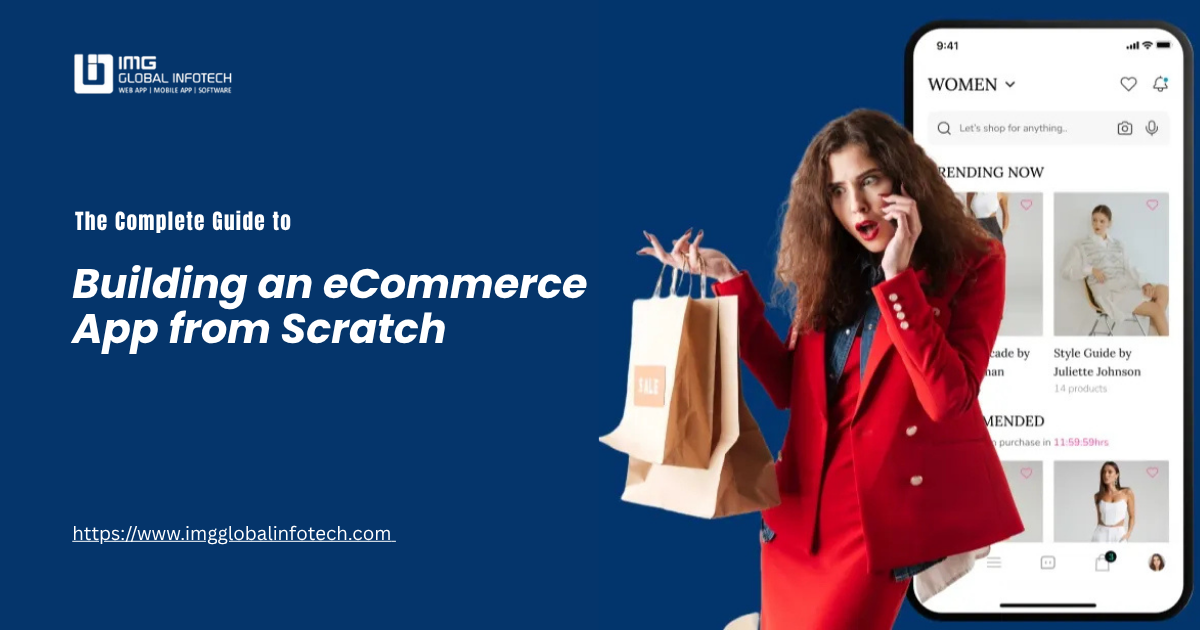In the era of online shopping and mobile-first consumers, having an eCommerce app isn’t just an added advantage—it’s a necessity. With global eCommerce sales expected to surpass $6 trillion in the coming years, businesses are increasingly shifting to mobile apps to meet growing customer demands, deliver seamless shopping experiences, and stay ahead of the competition.
But how do you turn a great product or service into a fully functional eCommerce mobile app? In this complete guide, we’ll walk you through every essential step to build an eCommerce app from scratch—whether you're a startup or an established brand. With professional input from IMG Global Infotech, a leading eCommerce app development company, this guide is both practical and strategic.
Step 1: Define Your Business Goals and Model
Before writing a single line of code, clearly define your goals. Are you selling physical products, digital goods, or services? Is your model B2C, B2B, C2C, or a multi-vendor marketplace?
Examples of common eCommerce models:
- Single-brand store (like Zara or Nike)
- Aggregators (like Flipkart or Amazon)
- Subscription-based services (like Dollar Shave Club)
Knowing your model helps in deciding your app structure, feature list, and monetization strategy.
Step 2: Conduct Market Research
Study your target market and analyze competitors. Identify:
- Customer pain points
- Competitor strengths/weaknesses
- Gaps in existing solutions
This research will guide your unique selling proposition (USP) and ensure you’re building something that solves real user problems.
Step 3: Choose the Right Platform
Based on your audience and budget, decide on the platform:
- Android (wider reach, especially in emerging markets)
- iOS (premium users and strong engagement)
- Cross-platform (cost-effective with frameworks like Flutter or React Native)
IMG Global Infotech assists businesses in choosing the most suitable platform by evaluating user demographics, technical feasibility, and budget constraints.
Step 4: Design a User-Friendly UI/UX
Your app’s design should prioritize simplicity, speed, and usability. A well-designed UI leads to better customer retention and higher conversion rates.
Must-follow design principles:
- Keep navigation simple and intuitive
- Use high-quality images and clean layouts
- Prioritize mobile responsiveness
- Reduce friction in checkout flow
IMG Global Infotech has a team of creative UI/UX designers who ensure the app is visually engaging and customer-focused.
Step 5: List of Must-Have Features
An eCommerce app should have a well-defined set of features that cater to both users and administrators.
User Side Features
- User registration/login (email, social login, OTP)
- Product catalog with categories
- Search & filter options
- Shopping cart and wishlist
- Secure checkout & payment gateways
- Order tracking
- Reviews & ratings
- Push notifications
Admin Panel Features
- Product management
- Inventory tracking
- Order management
- Customer support tools
- Offers & discount management
- Analytics dashboard
Advanced features like AI-based recommendations, voice search, and AR product previews can give your app a competitive edge.
Step 6: Choose the Right Tech Stack
The right technology stack ensures app performance, scalability, and future upgrades. A typical stack includes:
- Frontend: React Native, Flutter, Kotlin, Swift
- Backend: Node.js, Django, Laravel
- Database: MySQL, MongoDB, PostgreSQL
- Cloud Hosting: AWS, Google Cloud
- APIs: Payment gateways (Stripe, Razorpay), shipping APIs, SMS/Email notifications
IMG Global Infotech tailors the tech stack based on your app requirements, ensuring flexibility, speed, and cost-efficiency.
Step 7: Development & Integration
Once the UI/UX and architecture are finalized, the development phase begins. This includes:
- Setting up the backend and databases
- Creating frontend screens and components
- API integrations
- Security protocols (data encryption, secure login)
- Payment gateway and third-party services
A strong QA team at IMG Global Infotech ensures that every module is thoroughly tested for bugs, performance, and security.
Step 8: Testing & Quality Assurance
Before launch, the app must go through several rounds of testing:
- Functional testing: Checks if features work as expected
- UI/UX testing: Ensures usability
- Security testing: Detects vulnerabilities
- Performance testing: Tests load capacity and response time
- Device & OS compatibility testing
The QA team at IMG Global Infotech uses both manual and automated testing tools to guarantee a flawless launch.
Step 9: Launch & Deployment
After successful testing, your app is ready to be deployed to the App Store (iOS) and Google Play Store (Android). Ensure you:
- Follow app store guidelines
- Write engaging app descriptions
- Use high-quality screenshots
- Set up ASO (App Store Optimization) for visibility
IMG Global Infotech offers deployment and post-launch support to ensure a smooth rollout and initial user engagement.
Step 10: Ongoing Support & Maintenance
Post-launch support is critical to fix bugs, roll out updates, and improve features based on user feedback. Your maintenance plan should include:
- Regular app updates
- Monitoring performance
- Adding new features
- Customer feedback integration
- Technical support
With IMG Global Infotech, you get reliable post-launch services that ensure your app keeps running efficiently and evolves with your business.
The End Note
Building an eCommerce app from scratch is a complex yet rewarding journey. From planning and design to development and launch, each step requires strategic thinking and technical expertise. A well-built app can become a powerful sales channel, helping you reach more customers, boost conversions, and grow your brand online.
By partnering with a trusted development company like IMG Global Infotech, you gain access to a full-service team of developers, designers, and digital strategists committed to bringing your eCommerce vision to life.





Comments